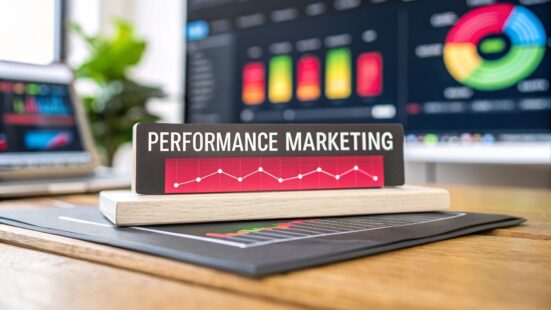 Influencer Marketing Hub: Boost Your Brand with Expert Strategies
Influencer Marketing Hub: Boost Your Brand with Expert Strategies
What if you only had to pay for marketing when it actually worked? When you got a real, measurable result, like a sale or a qualified lead. That’s not a hypothetical—it’s the core idea behind performance marketing.
This isn’t about just buying ad space and crossing your fingers. It’s a completely results-driven model where you pay for specific actions, not just eyeballs.
Table of Contents
A Simple Guide to Performance Marketing
At its heart, performance marketing flips the traditional advertising model on its head. Instead of paying upfront for ad placements and just hoping for the best, you’re investing in guaranteed outcomes. This approach seriously cuts down on the risk.
Think of it like hiring a salesperson who works purely on commission. They only get paid when they close a deal. It's the same principle here. Your marketing partners—whether they're affiliates, publishers, or social media platforms—only earn their money when a visitor completes a specific, predefined action.
This entire model is built on a foundation of transparency and accountability. Everything is trackable, and every dollar is accounted for.
Key Performance Marketing Models at a Glance
The payment structures in performance marketing are tied directly to the results you want. Here’s a quick look at the most common models to see how they connect actions to payments.
| Channel | Action Measured | Payment Model |
|---|---|---|
| Affiliate Marketing | A sale, lead, or sign-up is completed through an affiliate's unique link. | Cost Per Acquisition (CPA) or Revenue Share |
| Paid Search (PPC) | A user clicks on a search engine ad (e.g., Google Ads). | Cost Per Click (CPC) |
| Social Media Ads | A click, impression, lead, or conversion from a social media ad. | CPC, Cost Per Mille (CPM), or CPA |
| Native Advertising | A user clicks on an ad that matches the look and feel of the platform it's on. | Cost Per Click (CPC) |
| Display Advertising | An ad is shown a certain number of times on a website or app. | Cost Per Mille (CPM) |
As you can see, each model gives you a clear, direct line between your spending and the results you get. No more guessing games.

Ultimately, this hierarchy shows that every dollar you spend is linked to a specific, trackable outcome. It forces your budget to work smarter.
By zeroing in on measurable results, you can calculate your return on investment with pinpoint accuracy. This clarity allows you to make data-driven decisions on the fly, optimizing your campaigns for maximum profit. This fundamental shift—from paying for potential to paying for actual results—is what makes performance marketing so powerful.
Understanding the Pay-for-Results Model
Let's break down why performance marketing has become such a massive deal for so many businesses. Unlike old-school advertising—where you buy a billboard or a TV spot upfront and just cross your fingers—this model is all about accountability. Pure, simple, measurable results.
Think of it like hiring a rockstar salesperson who works 100% on commission. They only get paid when they actually close a deal. Performance marketing runs on that exact same logic. You only pay your partners, whether they're affiliates or ad networks, when a very specific, pre-agreed action happens.
That simple switch—from paying for potential eyeballs to paying for actual results—gives you a level of control over your budget that was unimaginable a couple of decades ago. It also gives you a crystal-clear picture of your return on investment.
The Focus on Actionable Outcomes
This "pay-for-results" idea isn't some fuzzy concept; it's incredibly precise. The actions you're paying for are all decided in advance and are tied directly to what you want to achieve as a business. We're not talking about vanity metrics here. We're talking about tangible events that move the needle.
Some of the most common payable actions include:
- Cost Per Click (CPC): You pay every time someone clicks on your ad. Simple as that.
- Cost Per Lead (CPL): You pay when a user gives you their contact info, like signing up for a newsletter or downloading an ebook.
- Cost Per Acquisition (CPA): You only pay when you get a new customer, which usually means after they've completed a purchase.
This setup forces every single marketing dollar to earn its keep. It cuts out the waste from campaigns that just aren't converting. It creates a true partnership where both the advertiser and the publisher are pulling in the same direction, working toward the same goal. It's a win-win.
"Performance marketing is the strategic discipline that encompasses the planning, channel selection, execution, measurement, and optimization of all performance advertising efforts. It is the framework that ensures all individual advertising tactics work in concert to achieve larger business goals."
This is exactly why the model has become a cornerstone of modern digital advertising. Its efficiency and built-in accountability are what's fueling its explosive growth. The global digital advertising market is on track to hit a staggering $1.16 trillion by 2030, and you can bet that performance-based campaigns are a huge slice of that pie.
How Accountability Drives Better Results
One of the best examples of this model in action is affiliate marketing. Here, partners promote your products and get a commission for every single sale they generate. It's the purest form of a pay-for-results strategy. If you want to dive deeper into how that works, check out our guide on what is affiliate marketing.
This image breaks down the core pieces of the performance marketing ecosystem.

You can see the key players—the advertisers, the publishers, and the networks that connect them. The diagram shows how actions and payments flow between them, highlighting how data and tracking are at the very heart of the process. It's this data-driven accountability that makes it possible to constantly tweak, optimize, and improve your ROI over time.
Exploring Core Performance Marketing Channels

Performance marketing isn’t a single tactic but an entire approach that comes to life across different digital platforms. These channels are the arenas where you connect with your audience, and the whole pay-for-results idea really takes shape. Knowing where this model works best is the first step in building a winning strategy.
Each channel has its own unique flavour, letting you reach different people in the specific ways they like to hang out online. From someone actively hunting for a solution on Google to another person casually scrolling through their social feed, there’s a performance channel for almost every digital moment. The real trick is picking the right mix to hit your specific goals.
Search Engine and Social Media Advertising
Search Engine Marketing (SEM) is a classic pillar of performance marketing for a reason. It’s all about placing paid ads right at the top of search engine results on places like Google or Bing. The power here is that you’re catching people with sky-high intent—they are literally typing in a search for a product or solution you offer. You typically pay on a Cost Per Click (CPC) basis, so you know every dollar is spent getting someone to your site.
Over on the social media side, advertising on platforms like Facebook, Instagram, and TikTok lets you get in front of users based on their demographics, interests, and online behavior. This is perfect for reaching potential customers who might not be looking for you right now, but absolutely fit your ideal customer profile.
By tapping into the incredible amount of user data on these platforms, social media ads can be hyper-targeted, making them wildly efficient for driving actions like clicks, leads, or sales.
These two channels are a perfect match. SEM is there to capture existing demand, while social media advertising helps create it, guiding people from that first spark of awareness all the way to conversion.
Affiliate and Native Advertising
Affiliate marketing is maybe the purest form of performance marketing out there. In this setup, you partner with third-party publishers—we call them affiliates—who promote your products or services to their own audiences. Just think of them as your commission-based digital sales force.
You only pay the affiliate when they successfully deliver a sale or a lead, usually on a Cost Per Acquisition (CPA) basis. This makes it an incredibly low-risk, high-reward channel for scaling up sales and breaking into niche communities you might not reach otherwise. It's a true partnership where everyone wins.
Finally, we have native advertising. This is all about placing ads that blend in seamlessly with the look, feel, and function of the platform where they appear.
- Sponsored articles on news sites that read just like the other editorial content.
- Promoted listings on e-commerce sites that pop up in category pages.
- In-feed social media posts that look almost identical to organic content.
This approach is so effective because it minimizes that disruptive, "in-your-face" ad feeling. People engage more because the ads feel less like a sales pitch and more like genuinely helpful, relevant content. That non-intrusive nature makes native ads a powerful tool in any performance marketer’s toolkit.
Measuring Success with the Right Metrics
In performance marketing, the old saying holds true: if you can't measure it, you can't improve it. Unlike traditional advertising where success can feel vague, here everything is tracked, analyzed, and optimized based on hard data.
This is what separates a guessing game from a predictable growth engine. These metrics aren't just report card grades; they are the very language of performance marketing. They tell you exactly what’s working, what isn’t, and where your budget should go next.
By getting a handle on a few core KPIs, you can start making smarter decisions that directly impact your bottom line.
Core Conversion and Cost Metrics
At the heart of performance marketing are the numbers that directly measure the cost of getting someone to take action. These are the metrics you’ll be checking daily to gauge the immediate health of your campaigns.
They give you a clean, simple answer to the question, "How much am I paying for this result?"
The most fundamental metrics here include:
- Cost Per Click (CPC): This is the price you pay each time someone clicks on your ad. It's a foundational metric for paid search and social campaigns, helping you understand the cost of simply driving traffic to your site.
- Cost Per Acquisition (CPA): This is the total cost to acquire one new customer. It’s arguably the most important metric because it ties your ad spend directly to a completed sale, making it a powerful indicator of how efficient your campaigns really are.
By focusing on your target CPA, you ensure every marketing dollar is spent on generating actual revenue, not just clicks or impressions. This direct link between spending and sales is the core of what performance marketing is all about.
These metrics give you instant feedback. If your CPA on a particular ad set is creeping up, you know it’s time to either refine the targeting, swap out the creative, or pause it altogether. This constant feedback loop is what makes agile campaign management possible.
Strategic Profitability and Value Metrics
While CPA and CPC tell you about immediate costs, another set of metrics gives you a bigger-picture view of profitability and long-term success. These KPIs help you understand the overall financial health of your marketing and make strategic decisions that go beyond a single campaign.
They answer the most important question of all: "Is my ad spend actually making me money?"
To figure this out, you need to look at:
- Return On Ad Spend (ROAS): This is the ultimate measure of profitability. It calculates the total revenue generated for every dollar you spend on advertising. A ROAS of 5:1 means you earned $5 for every $1 spent.
- Customer Lifetime Value (LTV): This metric forecasts the total profit your business can expect from a single customer over their entire relationship with your brand. Knowing your LTV allows you to set a more aggressive—but still profitable—CPA target.
For example, a $50 CPA might seem high for a product that sells for $70. But if you know the average LTV of that customer is $300, then paying $50 to acquire them suddenly becomes a highly profitable investment. This long-term perspective is key.
Similarly, for channels like influencer marketing where direct attribution can be tricky, understanding LTV helps justify the investment. You can find out more by exploring our detailed guide on how to measure influencer marketing ROI.
How AI Is Revolutionizing Performance Marketing

Let's be real, artificial intelligence isn't some far-off sci-fi concept anymore. It's here, and it’s completely changing the performance marketing game. AI algorithms are now crunching massive amounts of data in the blink of an eye, unlocking a level of personalization and automation we could only dream of a few years ago.
This isn't about just tweaking campaigns. It’s about moving past clunky, broad audience segments to deliver truly one-on-one experiences. Think of AI as your smartest team member, one who instinctively understands each customer's unique journey and knows exactly when to serve them the perfect ad.
Predictive Analytics and Hyper-Personalization
The real magic of AI in performance marketing is its ability to see the future. Machine learning models dig through user behavior, purchase history, and thousands of other signals to predict who is most likely to convert. This means you can stop guessing and start allocating your budget with surgical precision, focusing every dollar on users with the highest potential.
At the same time, AI is the engine behind hyper-personalization at scale. Forget creating a handful of ad variations. Now you can generate hundreds of tailored messages automatically. AI systems can dynamically change ad copy, images, and offers based on what a user is doing right now, sending engagement and conversion rates through the roof.
AI enables a shift from reactive to proactive marketing. By predicting customer needs and automating campaign adjustments, it ensures that every interaction is optimized for the best possible outcome, turning data into decisive action.
This isn't a minor tweak; it's a massive evolution. Marketers are taking notice. A recent study found that 71% of marketers plan to invest at least $10 million in AI over the next three years. That's a huge jump from just 57% the previous year, showing just how central AI is becoming. You can dig into more of these trends in these digital marketing statistics on Marketing Dive.
Automated Bidding and Campaign Optimization
Another game-changer is how AI handles complex bidding strategies. Platforms like Google Ads use AI to analyze countless variables in milliseconds, figuring out the perfect bid for each ad placement to maximize your ROAS. All without you having to constantly babysit the campaigns.
This automation frees you and your team from the daily grind of tactical adjustments, letting you focus on big-picture strategy. From A/B testing thousands of creative variations to shifting budgets between channels on the fly, AI keeps your campaigns running at peak efficiency. It’s even shaping how brands find and work with creators. In fact, our guide explains how to collaborate with influencers in this new, data-first environment. Embracing AI isn't just an option—it's how you get a serious competitive edge.
Real-World Examples of Performance Marketing in Action
Theory is great, but performance marketing really comes to life when you see it drive actual, measurable wins. Let's look at some real stories of brands that decided to pay only for results, making every single dollar accountable.
For instance, one e-commerce store was struggling with high customer acquisition costs. By shifting to hyper-targeted social media campaigns, they slashed that cost by a massive 35%. Even better, their weekly revenue shot up from $20,000 to $27,000 in just one month. That’s the dream: ad spend that directly fuels sales with a crystal-clear ROI.
In another scenario, a software company needed to generate leads without a massive upfront budget. They turned to affiliate partnerships and brought in 2,000 new leads in only six weeks. Their affiliates acted like a commission-only sales force, promoting the software on blogs and podcasts. Payouts only happened when they hit specific lead targets, which took almost all the financial risk off the company's shoulders.
Those are some impressive results, right? Now, let's break down the specific actions that made them happen.
- Social Media Ads: They didn't just throw ads out there. They meticulously aligned the ad creative with user interests, which lifted their click-through rates by 20%.
- Affiliate Programs: Partners promoted products to their own niche audiences, earning a commission for every single qualified lead they sent over.
- Programmatic Display: They used automated, real-time bidding to snatch up low-cost impressions that were laser-focused on driving conversions.
These aren't just abstract strategies; they are tactics that create direct accountability between spending and results.
Case Studies in E-Commerce Ads
Let's dive deeper into one of those stories. A fashion retailer started treating its ad budget like a pro athlete treats their training time—every second had to count. They focused relentlessly on A/B testing different ad creatives on Facebook and Instagram.
It didn't take long to find a winner. One video ad started outperforming everything else by 15% in conversions. The team’s response was immediate and decisive: they redirected 70% of their entire budget to that single, high-performing ad.
“Switching budgets only to top performers turbocharged our ROI,” the retailer’s marketing lead told us.
A quick look at the numbers tells the whole story:
| Channel | Cost Per Acquisition | Conversion Lift |
|---|---|---|
| Facebook Video Ads | $12 | 15% |
| Instagram Carousel | $18 | 8% |
Numbers like these are what make performance marketing so tangible and powerful. There's no guesswork involved.
Affiliate Partnership Success
Next up, let's look at a B2B software startup that built an affiliate network from scratch. They identified 50 influential industry blogs and offered them a simple deal: $10 for every qualified demo signup sent through a unique tracking link.
Over three months, they spent $20,000 on commissions. The result? A staggering 2,000 demos were booked.
Here’s the simple, three-step playbook they used for that campaign:
- Recruit Affiliates: They went straight to the experts—niche bloggers whose audiences were a perfect match.
- Set Clear Goals: They paid only for demos. Clicks and impressions were irrelevant, eliminating wasted spend.
- Optimize Creatives: They armed their affiliates with on-brand visuals and proven ad copy to make promotion easy.
This systematic approach completely changed how the startup thought about its marketing budget. It wasn't an expense anymore; it was a direct investment in growth.
In every one of these examples, the magic isn't in some complicated formula. It's in the simple principle of paying for actions, not just potential. That's the core of what performance marketing is.
When you can tie every dollar you spend to a tangible result, you gain the confidence to scale your efforts with precision. Think of these case studies as blueprints. You can adapt the steps, test aggressively, and watch your own KPIs start to climb. These stories prove just how critical measurable campaigns are for real growth.
So, define your objectives, pick the right channel mix, and keep a close eye on metrics like CPA, ROAS, and LTV. It's time to make your marketing work for you.
Got Questions? We've Got Answers
Even after getting the hang of performance marketing, a few questions always seem to pop up. Let's tackle some of the most common ones to clear things up.
What's the Real Difference Between Performance and Brand Marketing?
The biggest difference boils down to the goal and how you measure success. Brand marketing is all about the long game—building awareness, shaping how people feel about your brand, and earning their loyalty. The ROI on that is often fuzzy and hard to pin down.
Performance marketing, on the other hand, is all about driving specific, measurable actions like sales, leads, or clicks. Every single dollar you spend is tied directly to a result you can see and count.
Can a Small Business Actually Use Performance Marketing?
Absolutely. In fact, it's pretty much perfect for small businesses because it keeps financial risk low. You're only paying for results, which means your budget is spent on what actually works—a lifesaver when every penny counts.
Channels like paid social media and affiliate marketing are great starting points because they don't require a huge upfront investment and you can scale them as you grow.
Think about it: a small e-commerce shop can dip its toes in with a small budget for super-targeted Facebook ads. They only pay when someone clicks (CPC) or, even better, when someone buys (CPA). This lets them test, learn, and grow without betting the farm.
How Do I Get a Performance Marketing Campaign Off the Ground?
Getting started isn't as complicated as it sounds. It really comes down to a few key steps:
- Nail Down Your Goal: What, exactly, do you want people to do? Make a purchase? Sign up for your newsletter? Be specific.
- Pick Your Channels: Go where your people are. Are they scrolling through Google Ads, watching TikTok, or reading affiliate blogs? Choose wisely.
- Set Your Budget and KPIs: Figure out what you're willing to pay for each action (your target CPA or CPL) and decide on an overall budget for the campaign.
- Launch and Watch Closely: Get your campaign live, then keep a close eye on your performance metrics. The goal is to constantly tweak and optimize to get the best possible results.
Ready to amplify your brand's reach with the power of creator partnerships? With JoinBrands, you can connect with over 250,000 creators to generate authentic UGC, launch influencer campaigns, and drive sales. Find the perfect creators for your brand and manage your campaigns seamlessly, all in one platform. Start your creator marketing journey with JoinBrands today!








